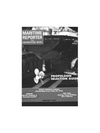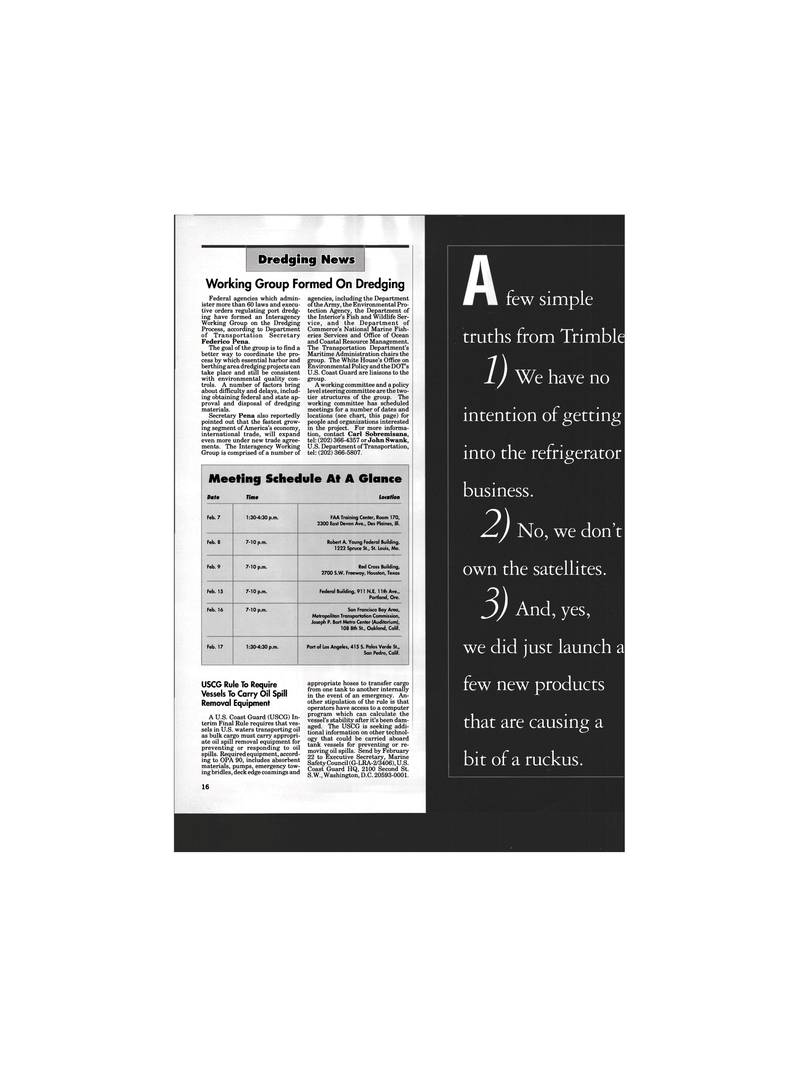
Page 10: of Maritime Reporter Magazine (February 1994)
Read this page in Pdf, Flash or Html5 edition of February 1994 Maritime Reporter Magazine
few simple truths from Trimble 1.) We have no intention of getting into the refrigerator business. 2) No, we don't own the satellites. 3) And, yes, we did just launch a few new products that are causing a bit of a ruckus.
Dredging News
Working Group Formed On Dredging
Federal agencies which admin- ister more than 60 laws and execu- tive orders regulating port dredg- ing have formed an Interagency
Working Group on the Dredging
Process, according to Department of Transportation Secretary
Federico Pena.
The goal of the group is to find a better way to coordinate the pro- cess by which essential harbor and berthing area dredging projects can take place and still be consistent with environmental quality con- trols. A number of factors bring about difficulty and delays, includ- ing obtaining federal and state ap- proval and disposal of dredging materials.
Secretary Pena also reportedly pointed out that the fastest grow- ing segment of America's economy, international trade, will expand even more under new trade agree- ments. The Interagency Working
Group is comprised of a number of agencies, including the Department of the Army, the Environmental Pro- tection Agency, the Department of the Interior's Fish and Wildlife Ser- vice, and the Department of
Commerce's National Marine Fish- eries Services and Office of Ocean and Coastal Resource Management.
The Transportation Department's
Maritime Administration chairs the group. The White House's Office on
Environmental Policy and the DOT's
U.S. Coast Guard are liaisons to the group.
A working committee and a policy level steering committee are the two- tier structures of the group. The working committee has scheduled meetings for a number of dates and locations (see chart, this page) for people and organizations interested in the project. For more informa- tion, contact Carl Sobremisana, tel: (202) 366-4357 or John Swank,
U.S. Department of Transportation, tel: (202) 366-5807.
Meeting Schedule At A Glance
Date Time lotation
Feb. 7 1:30-4:30 p.m. FAA Training Center, Room 170, 2300 East Devon Ave., Des Plaines, III.
Feb. 8 7-10 p.m. Robert A. Young Federal Building, 1222 Spruce St., St. Louis, Mo.
Feb. 9 7-10 p.m. Red Cross Building, 2700 S.W. Freeway, Houston, Texas
Feb. 15 7-10 p.m. Federal Building, 911 N.E. 11th Ave.,
Portland, Ore.
Feb. 16 7-10 p.m. San Francisco Bay Area,
Metropolitan Transportation Commission,
Joseph P. Bort Metro Center (Auditorium), 108 8th St., Oakland, Calif.
Feb. 17 1:30-4:30 p.m. Port of Los Angeles, 415 S. Palos Verde St.,
San Pedro, Calif.
USCG Rule To Require
Vessels To Carry Oil Spill
Removal Equipment
A U.S. Coast Guard (USCG) In- terim Final Rule requires that ves- sels in U.S. waters transporting oil as bulk cargo must carry appropri- ate oil spill removal equipment for preventing or responding to oil spills. Required equipment, accord- ing to OPA 90, includes absorbent materials, pumps, emergency tow- ing bridles, deck edge coamings and 16 appropriate hoses to transfer cargo from one tank to another internally in the event of an emergency. An- other stipulation of the rule is that operators have access to a computer program which can calculate the vessel's stability after it's been dam- aged. The USCG is seeking addi- tional information on other technol- ogy that could be carried aboard tank vessels for preventing or re- moving oil spills. Send by February 22 to Executive Secretary, Marine
Safety Council (G-LRA-2/3406), U.S.
Coast Guard HQ, 2100 Second St.
S.W., Washington, D.C. 20593-0001.

 9
9

 11
11
